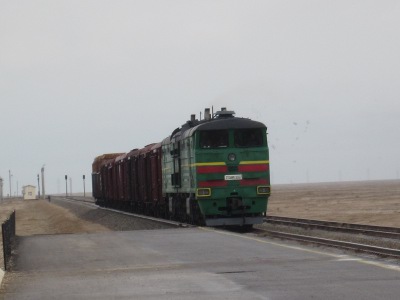Afghanistan Reconstruction & Development Services has published the Afghanistan Railway Authority’s invitation for expressions of interest in three contracts covering the operation, maintenance and management of the Hairatan to Mazar-i-Sharif railway.
Responses from “experienced, high caliber and competent national and international rail operating, maintenance and management companies” should be submitted to the Ministry of Public Works by 5:00 pm local time on 15 November 2014.
Soliciting expressions of interest is the first step of a possible bidding process. Evaluation would be conducted internally within AfRA/MPW according to Afghan procurement law and procedures. Companies which are shortlisted would be invited to submit their proposals.
The invitation document says the Hairatan to Mazar-i-Sharif railway comprises 75 km of main line and 63 km of loop line, a total of 138 km, which “went into operation in December 2011 and has been successfully operated, maintained and managed.”
The performance-based operation and maintenance services would include but not be limited to:
- Quantification of assets and characteristics of the railway system
- Required Operations services
- Required Infrastructure Maintenance services
- Required Management services
- Technical specifications and standards
- Necessary equipment for proactive for operations and maintenance
- Performance standards, including benchmarks of operational, rolling stock, and infrastructure asset maintenance; targets of goods to be transported per year; maintenance of infrastructure; correction of defective maintenance; type and availability of trains; procedures for delays, accidents, and incidents; and locomotive and wagon maintenance.
- Outline of the revenue account for revenue deposits, maintained by the operator and transferred at fixed intervals to the owner
- Quality management to meet best industry standards of O&M
- Performance securities and insurance
- Format of a summary of usage report to record operator activities performed
- Establishment of an operating account, outlining costs and revenues
- Environmental management plan
- Description of force majeure events, conditions, or circumstances
- Training for staff on O&M
- Dispute resolution mechanism
Interested companies should demonstrate:
- 10 Years Similar experience in Rail operations, Management and Maintenance of 1520 mm and/or 1435 mm gauges railway lines.
- Reasonable and adequate financial resources
- Regional experience and joint-venture with national firms is plus
- Human resource capacity to operate, manage and carry out infrastructure maintenance
- Adequate machinery, rolling-stock, tools and equipment
- Good performance record
- Companies are advised to provide only materials that are specific to the proposed service as to avoid submitting generic promotional material.
The call for expression of interest also gives AfRA’s description of itself:
Afghanistan Railway Authority (AfRA) is the governing body for all railway planning, development, network, operations and maintenance in Afghanistan.
Based on our vision of long-term rail development, we will ensure all rail stakeholders are, committed to the safety of employees, customers and the public. We feel that a progressive railway network can be operated with integrity, having concern and consideration for our neighbors, the local community, and the environment.
We stand committed to the safe and efficient movement of resources, goods, humans, animals and information material to, from, and through Afghanistan by developing an integrated National Railway Plan, sustainable policies, safety and operational regulations as well as becoming a contributing member of regional and international partnerships.
The AfRA is responsible for legal and regulatory policies governing rail investment, development, and operations. This includes the regulatory oversight needed for a safe, efficient, and reliable rail network. The AfRA is also the sole governing body in charge of planning, survey, design, construction and operations of the entire railway lines in Afghanistan. AfRA will ensure railway companies and stakeholders are engaged corporate citizens, committed to the safety of employees, customers and the public.
